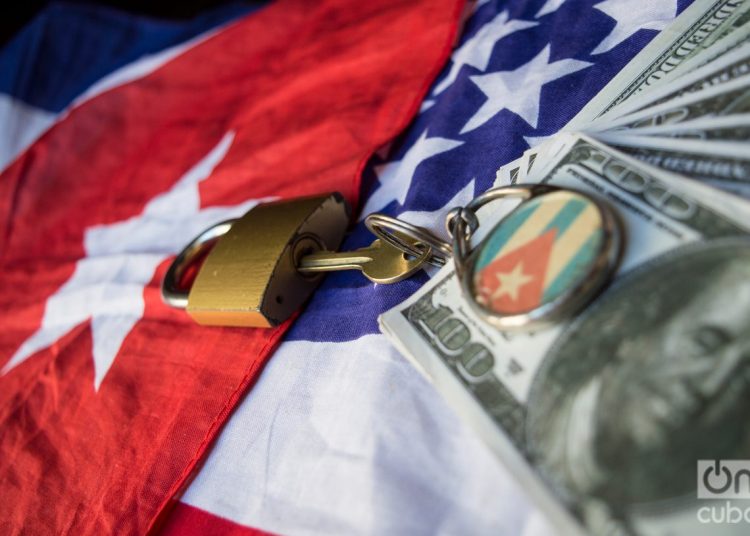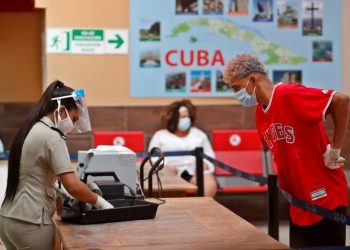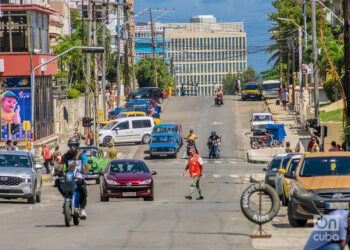I don’t forget the day of my first interview with the Federal Bureau of Investigation (FBI). After politely asking me if I was willing to talk, two young men, representing the Bureau, invited me to meet in a cafeteria. An hour and a half later they said goodbye, leaving me their cards and they were emphatic about the fact that I call them if I had any problem. Our entire conversation dealt with a single question: what did I think of “the Miami Cubans”?
Juan Valdés Paz, co-author with me of two studies on the social structure of the Cuban community in the 1980s, published in Cuadernos de Nuestra América, was amused by the idea that perhaps the FBI read the CEA magazine more carefully than others here. In any case, that morning in the cafeteria I had the impression that the Bureau’s interest in our views on that community, including the institutions and personalities that were not very sympathetic to the Revolution, was authentic.
In any case, to understand the political ins and outs of what Alejandro Portes has called “the enclave,” and the successive waves that Lisandro Pérez and Guillermo Grenier identify as “migratory cohorts,” I have been able to learn a lot from living sources. I especially remember the spiritual sessions shared, when I was passing through that blessed city, with the University of Miami professor Enrique Baloyra, leader of the Democratic Platform, or the president of the Cuban Studies Institute, María Cristina Herrera, whose respective hospitality and trust I appreciated and still miss. Thanks to Enrique and María Cristina, and others like them, including those who did not want to or could not enter Cuba, I learned much of what I know about the intra-politics of the opposition and its emigration, from the historical exile to dissidence; as well as about the layers of a political culture that is anything but homogeneous.
Since then, I have come across all kinds of people among those who call themselves “exiles, anti-Castro, dissidents.” Many of these people without a clear and distinct ideology; others with diverse affiliations, from liberals and Christian Democrats to self-identified as Democratic Communists; all opposed to the government and current or reformed socialism. Some of them with deep convictions; others resentful of injustices suffered; or disappointed by the course of actual politics and the path taken; or those who were already opportunists before going to the opposition.
In this diverse group, there are those who did not leave under persecution or conflict, who can return and even regain their permanent residence on the island, where they never suffered prison for their way of thinking and expressing themselves. I have not met most of them through television or reading what they write to me on the networks, but up close, there and here. I have shared academic events with many of them, they have sat in my classes, they have participated in panels and debates I have organized, as well as in work teams under my charge, we have compiled books and written prologues, they have invited me to collaborate with their editorial projects. In many cases, they have communicated with me over the years, they have sent me their comments and opinions, they have autographed their books, we have talked in bars and canteens, and even in their own homes.
I have been writing for twenty years about the plurality of origins of this community (Mirar a Cuba, 1993). Despite the greater visibility of those from the artistic culture sector, I met many of them when they were Granma journalists, university professors of philosophy, economy or higher education leaders, State Security officers, officials of the Central Committee of the Communist Party of Cuba (PCC). At that time they were not critical socialists, but “official,” as they say now. I have never doubted the right to repent of previous beliefs, precisely because it is the case of many of these people.
Most of the opponents I am friendly with were not from the latter group. Contrary to what is taken for granted, those who have always been against the Revolution are often more capable of dialogue than the repentant or those who seem to be members of a kind of union of anti-communist youth. I have observed something similar between Catholics and Protestants. The believers and ecclesiastics who suffered the harshness and discrimination of the 1960s and 70s, paradoxically, are less intransigent and more in favor of dialogue with the socialists than the more recent ones. A veteran Catholic of those times explained it to me like this: “We suffered so much then that we learned to live together and cultivate a spirit of reconciliation and tolerance, which made us better Christians. They [the most recent ones] didn’t go through that.”
Regarding the spirit of dialogue of this current dissident discourse, I have some evidence taken from what researchers call “field work.” In a recent article, written at the request of a Latin American journal of Social Sciences, I try to examine the sociological profile of the 27N group and its context, identifying all its actors, including official institutions, their deficiencies and contradictions, based on sources from one side and the other. Although my text disagrees with the generalized characterization of mercenaries or criminals in the service of the United States, it has been disqualified by dissident discourse as an act of “complicity” (with the government), “a gross manipulation,” “malicious,” “expression of a gagged conscience,”“ irresponsible,” “justification of police violence,” “dishonest,” “shameful.” I spare the reader other worse epithets.
Each trade has its professional illness, Fernando Martínez used to say sarcastically to me. An old friend who knows a lot about digital journalism advised me to be ready to put up with these issues. What I’m interested in rescuing here, after all, is that it’s not an isolated event.
As cytological evidence of the position of the opposition press, we can take its reaction to the open letter to Biden promoted by La Joven Cuba (LJC), which calls for the end of the embargo. They disqualify this document for “its intentions and interests from the moment it distances itself from the question of human rights on the island”; and they characterize the signatories as an “apparently heterogeneous,” group, whose partiality is demonstrated because “journalists, activists and opponents are not among them.” I confess that this absence also intrigues me: if these journalists, activists and opponents defend the interest of the Cuban nation, what prevents them from condemning the embargo and its promoters in the United States, as is done by so many people in the world?
In doing so, they not only distance themselves from the criticism of the blockade, they also identify with the super Spanish right. They cite in their favor no less than Hermann Tertsch, journalist and “extreme right-wing MEP” (according to El País), sentenced by the Supreme Court of Spain to two fines (15,000 and 12,000 euros) for personal injury against other political leaders. This libertarian sympathizer of the Cuban cause says in a tweet that he is fed up with those who sign letters “in favor of the dictatorship and its criminal leadership,” and qualifies it as a “pamphlet letter with all the victimizing discourse of the regime.”
If the Diario de Cuba sample was not enough to confirm the previous cytological test, Cibercuba’s open letter placing conditions on the normalization, including that of seating the dissence and its media at the Cuba-U.S. negotiating table, make up what my legal friends call “a confession of parts, relief of evidence.” This recent step allows us to update with names and surnames the composition and peculiar nationalist vocation of this dissidence, and its policy of linkage between an internal change agenda and the use of the U.S. factor, as well as the precise distance that separates it from the group of signatories of the letter promoted by LJC.
The previous cases allow us to compare some characteristics of our third generation dissidence and of the independent opposition media with respect to what they say about themselves. First: To what extent are forums and channels only committed to universal principles, such as human rights? Second: What is the measure of their real capacity to represent the Cuban nation in its plurality and extension, in its diversity? Third: Do they embody movements rooted in sectors of real Cuban civil society? What are these social sectors? Fourth: Do they represent social groups that are disadvantaged, marginalized, without rights, helpless and voiceless, poor, invisible? The blacks of San Isidro? LGTBQs? Religious believers? Writers, artists, journalists, teachers, scientists? Fifth: Do they coexist with any other ideology that is not anti-communism? Sixth: In the case of the media, are they faithful to their declaration of “informing the public without ideological or partisan ties,” “without disqualifications,” “without any kind of militancy,” “without pedagogical pretenses”? Seventh: Do they behave as if they could really represent a desirable alternative to the ills of the Cuban political system and the deficiencies of its media system?
As can be seen, none of these seven objections includes receiving funds from agencies linked to the U.S. government or from anti-communist Hungarian millionaires. Not because this lacks significance, but because the main thing, for me, is in what they spend those funds, and above all, the support received not only in money, but in terms of power relations, which make these victims of Cuban totalitarianism stars of the great media and paradigms of the fight for freedom of thought.
The European right is not the only conservative supporter of this dissidence. The present circumstance has led to some other currents, not exactly foreign, having manifested themselves; as is the case of the Catholic Church and some of its representatives.
Such a lucid and insightful observer of Cuban society, culture and politics as Monsignor Carlos Manuel de Céspedes, regrettably absent for five years, had pointed out that “the bishops—the Catholic hierarchy in Cuba—have not historically distinguished themselves for their talent to direct—‘shepherd’—the political dimension of the life of the Church.” Instead of the burning bush through which Yahweh (Jehovah) dictates to the prophet the tables of the law as the absolute guide of the people chosen by God, Monsignor Carlos Manuel recommended to the “Catholic Church to assume, limpid and consciously, our growing miscegenation and its repercussions in the religious field”; as well as “the separation from the institutional Church and, especially, from its hierarchy, from political life according to the criteria, paths and dynamism typical of party politics….” to “approach one’s own paths,” “use of language appropriate to evangelical values (respect, understanding love, serenity, trust),”“ together with the promotion of the culture of tolerance and pluralism concomitant with human nature.”
This reference is also relevant, because, to a large extent, among the opposition groups the intransigent spirit of the Congregation for the Doctrine of the Faith prevails more—if not the harsh rhetoric of the Holy Office—than the banner of national reconciliation and dialogue.
As is known, one does not have to have been trained in the pedagogy of Marxism-Leninism of the manuals to be dogmatic. Nor is it required to have discriminated against or punished the unfaithful to that legacy to be sectarian, or to have directed brigades against hippies and gays in La Rampa. Sectarianism is replicated in groups that are outright anti-dogmatic; or having an open or decentralized, apparently pluralistic structure; and it is also enthroned in currents considered iconoclasts, questioners of a certain status quo, who postulate their own pattern of what is politically correct and what is not.
As the psychologists of religion have shown, the spirit of sect is built by assertion, in the manner of those who defend a faith and process it inward, instead of developing communication strategies with other groups that think differently from them. This spirit attacks its own members, when it perceives them as noncompliant with the principles of the group, often with more zeal and harshness than with the enemies. Anyone who disagrees with this rule deviates, and therefore may be more dangerous—because he is or has been within the ranks—than the enemy itself. The sectarian style is the same when it rebukes the opponents, identifying them in bloc as “sold out” and “mercenaries”; or attributing to them “silence in the face of abuse,” “self-censorship,” “cowardice,” “complicity with the regime.”
This is an especially complex situation for Cuban politics and its institutions. The 8th Congress of the PCC is approaching, which includes another change of political leadership. Subject to returning to this event and its historical moment, the situation seems to demand a permanent calibration of the measures adopted, aimed at achieving not only the efficiency pursued by the economic policy of the Reorganization.
However, accomplishing this complicated task of the economy, which is not merely technical, requires fostering social and political conditions. For example: maximizing a consensus that is today more heterogeneous and contradictory at the level of civil society; developing a media policy that facilitates political dialogue between leaders and those who are led, and that overcomes obsolete ideological lessons; practicing a style of leadership that deals with dissent within that society and channels its energy; as well as a more effective way of facing the interests that promote the erosion and fragmentation of this consensus, deploying the resources of politics, from the government and from society, to a greater extent than those of law and order.
In a text1 almost twenty years ago about Cuban thought in the 20th century, its co-author and I affirmed that appreciating intellectual value did not imply ignoring its political imbrication, nor ignoring its ideological character. We recognized that among the most outstanding thinkers of Cuban culture there were people of different political affiliations, classes, generations, genders, sexualities, colors and ethnic identities, who had lived inside and outside the island. Hence, it is fundamental, if it’s a question of cultural and nation, to distinguish the cultural value of that thought, and separate it from doctrinal formulations and pamphleteering expressions.
In the midst of so much pamphlet masquerading as journalism, conservative indoctrination that usurps critical thinking, sectarianism wrapped in the banner of democracy, monologues that claim to advocate dialogue and the debate of ideas, and extremisms that polarize consensus, it would be worth stopping to think, with one’s own head, and wondering where the national interest really lies.
***
Note:
1 Rafael Hernández and Rafael Rojas, “Prólogo” (Ensayo cubano del siglo XX. Antología. Fondo de Cultura Económica, Mexico, 2002, p. 8 and 9).










